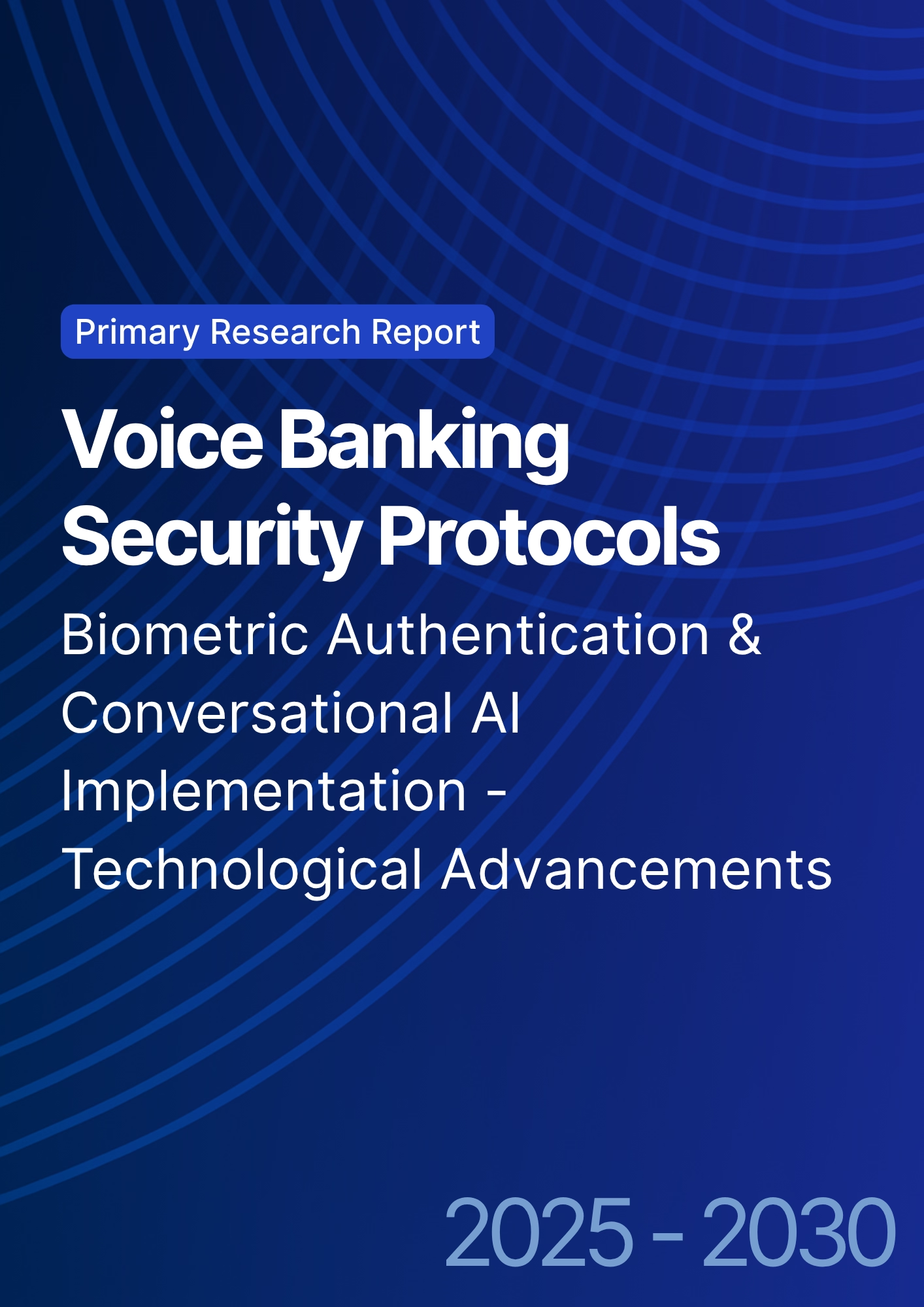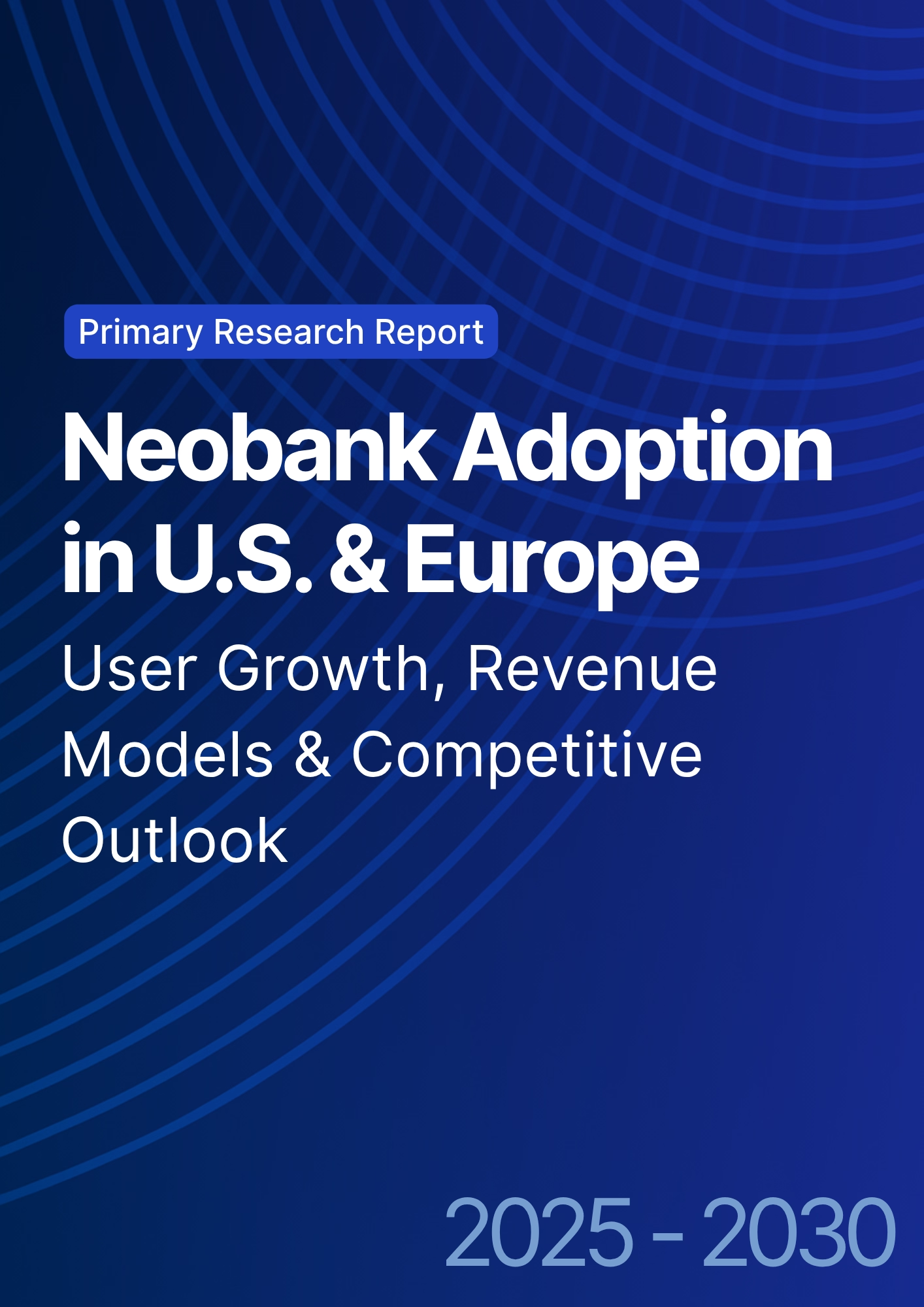

68 Circular Road, #02-01 049422, Singapore
Revenue Tower, Scbd, Jakarta 12190, Indonesia
4th Floor, Pinnacle Business Park, Andheri East, Mumbai, 400093
Cinnabar Hills, Embassy Golf Links Business Park, Bengaluru, Karnataka 560071
Connect With Us
Voice Banking Security Protocols: Biometric Authentication & Conversational AI Implementation - Technological Advancements
This research examines Voice Banking Security Protocols in UK and Europe from 2025 to 2030, focusing on biometric authentication and the integration of Conversational AI. The report explores how voice biometrics will enhance security in banking transactions, while Conversational AI will streamline customer service. It highlights the role of AI-powered voice recognition in reducing fraud, improving user experience, and optimizing operational efficiency. The study offers insights for banks, financial institutions, and tech developers looking to implement secure, voice-enabled banking solutions.

What's Covered?
Report Summary
Key Takeaways
- Voice banking security market in UK and Europe projected to grow from $1.5 billion in 2025 to $12 billion by 2030, CAGR 52%.
- Biometric voice authentication will improve fraud detection by 35% by 2030.
- Conversational AI in voice banking expected to streamline customer service operations, reducing response time by 50%.
- Fraud prevention using voice biometrics will reduce identity theft by 40% by 2030.
- Voice banking adoption in the UK and Europe projected to reach 50% of banking transactions by 2030.
- Banks and financial institutions are expected to invest $6 billion annually in voice banking security technologies by 2030.
- Voice recognition systems will improve user verification accuracy by 45% by 2030.
- Customer satisfaction is expected to increase by 30% with the integration of Conversational AI in voice banking.
- Cross-border voice banking transactions are projected to increase by 30% by 2030, as voice security protocols improve.
- ROI from implementing voice banking security protocols is expected to be 20-25% by 2030.
Key Metrics
Market Size & Share
The voice banking security market in UK and Europe is expected to grow significantly from $1.5 billion in 2025 to $12 billion by 2030, reflecting a CAGR of 52%. The key drivers of this growth include the increasing adoption of biometric authentication and Conversational AI in banking services. Voice biometrics will become central to fraud detection, improving security by 35% and reducing identity theft by 40% by 2030. By 2030, voice banking will account for 50% of banking transactions in UK and Europe, with banks and financial institutions investing $6 billion annually in voice banking security technologies. Voice recognition systems will improve user verification accuracy by 45% by 2030, ensuring faster and more secure access to financial services. The integration of Conversational AI will reduce response time by 50%, improving customer service efficiency and increasing customer satisfaction by 30%. Cross-border transactions will increase by 30% as voice security protocols become more standardized and interoperable. The expected ROI from implementing voice banking security protocols is 20-25% by 2030, driven by enhanced efficiency, security, and customer experience. The adoption of these technologies will also streamline banking operations and reduce operational costs in the long term.
.png)
Market Analysis
The voice banking security market in UK and Europe is experiencing rapid growth, projected to rise from $1.5 billion in 2025 to $12 billion by 2030, with a CAGR of 52%. The increasing reliance on voice biometrics for identity verification and fraud detection will drive security improvements, with fraud detection accuracy expected to improve by 35% by 2030. Conversational AI will enhance customer service operations, reducing response time by 50% and increasing customer satisfaction by 30%. The integration of voice biometrics will improve identity verification processes, reducing the risk of identity theft by 40% and making voice banking more secure. By 2030, voice banking transactions in the UK and Europe will account for 50% of all banking transactions. The increased use of blockchain technology will enhance asset traceability and ensure more secure and efficient transactions, driving cross-border adoption and increasing transaction volume by 30%. By 2030, financial institutions are expected to invest $6 billion annually in voice banking security protocols to enhance the accuracy and efficiency of their banking systems. The ROI from voice banking security is projected to be 20-25% by 2030, driven by operational efficiency, cost savings, and improved customer trust.
Trends & Insights
The voice banking security market in UK and Europe is set to grow rapidly, from $1.5 billion in 2025 to $12 billion by 2030, representing a CAGR of 52%. The key trend driving this growth is the increasing adoption of biometric authentication and Conversational AI in banking services. Voice biometrics will significantly improve fraud detection accuracy, expected to increase by 35% by 2030, while identity theft in voice banking will decrease by 40%. Conversational AI will streamline customer service, reducing response times by 50% and increasing customer satisfaction by 30%. Voice recognition systems will improve user verification accuracy by 45%, enabling faster and more secure banking transactions. Cross-border voice banking transactions will grow by 30% by 2030, as regulatory frameworks improve and security protocols become more standardized. By 2030, financial institutions are projected to invest $6 billion annually in voice banking security, capitalizing on the growth of voice-enabled banking. ROI from implementing voice banking security protocols is projected at 20–25% by 2030, driven by improvements in security, efficiency, and customer experience. As blockchain technology enhances asset traceability by 50%, voice banking will become a more secure, efficient, and customer-friendly option for financial transactions.
.png)
Segment Analysis
The voice banking security market in UK and Europe is segmented into biometric authentication, Conversational AI, and cross-border voice transactions. By 2030, biometric voice authentication will account for 40% of the total market, with a market size of $4.8 billion, as financial institutions increasingly adopt voice recognition technology for fraud prevention and identity verification. Conversational AI in voice banking will capture 30% of the market, valued at $3.6 billion, as it enhances customer service operations, improving response times and satisfaction. Cross-border voice banking transactions will contribute 30% of the market, driven by the standardization of voice security protocols and improved regulatory compliance across EU and UK jurisdictions. The ROI from adopting voice banking security technologies is expected to reach 20–25% by 2030, driven by reduced fraud, improved transaction speed, and increased customer engagement. Financial institutions and tech providers will account for 70% of the market share, as banks invest in secure and AI-powered voice banking systems to improve security and customer experience. Blockchain technology will increase asset traceability by 50%, enhancing the security and trust of voice-enabled financial transactions.
Geography Analysis
The voice banking security market in UK and Europe is projected to grow significantly, from $1.5 billion in 2025 to $12 billion by 2030, with voice biometric authentication accounting for 40% of market share by 2030. The UK and EU will lead adoption, as financial institutions incorporate biometric voice recognition and Conversational AI into their operations. Conversational AI will streamline customer service, improving response times by 50% and customer satisfaction by 30%. Fraud detection will improve by 35%, and identity theft will reduce by 40% through voice biometrics. By 2030, cross-border voice banking transactions will increase by 30%, as blockchain technology ensures data security and enables regulatory compliance across EU and UK jurisdictions. ROI from adopting voice banking security protocols will be 20-25% by 2030, driven by cost savings, improved efficiency, and enhanced security. The adoption of blockchain technology will increase asset traceability by 50%, providing more secure and transparent transactions. Financial institutions are expected to invest $6 billion annually in voice banking security technologies by 2030, as they seek to improve customer experience and secure voice-based transactions across Europe.
.png)
Competitive Landscape
The voice banking security market is competitive, with leading players like Nuance Communications, Verint Systems, and Pindrop providing biometric voice authentication and Conversational AI solutions. These companies are developing AI-powered platforms to enhance fraud detection, identity verification, and customer service. By 2030, financial institutions will account for 70% of the market share, as banks and payment service providers (PSPs) integrate voice-enabled banking solutions into their operations. The increasing use of biometric authentication will drive security improvements, while Conversational AI will improve customer engagement by enabling faster, personalized responses. Cross-border voice banking transactions will grow by 30%, as blockchain technologies enable secure, efficient transactions across EU and UK borders. The ROI from implementing voice banking security protocols is expected to reach 20-25% by 2030, driven by reduced operational costs, faster transaction processing, and enhanced customer satisfaction. The competitive landscape will be shaped by partnerships between financial institutions and tech providers, fueling further innovation in AI-powered voice banking systems.
Report Details
Proceed To Buy
Want a More Customized Experience?
- Request a Customized Transcript: Submit your own questions or specify changes. We’ll conduct a new call with the industry expert, covering both the original and your additional questions. You’ll receive an updated report for a small fee over the standard price.
- Request a Direct Call with the Expert: If you prefer a live conversation, we can facilitate a call between you and the expert. After the call, you’ll get the full recording, a verbatim transcript, and continued platform access to query the content and more.


68 Circular Road, #02-01 049422, Singapore
Revenue Tower, Scbd, Jakarta 12190, Indonesia
4th Floor, Pinnacle Business Park, Andheri East, Mumbai, 400093
Cinnabar Hills, Embassy Golf Links Business Park, Bengaluru, Karnataka 560071
Request Custom Transcript
Related Transcripts
$ 1450


68 Circular Road, #02-01 049422, Singapore
Revenue Tower, Scbd, Jakarta 12190, Indonesia
4th Floor, Pinnacle Business Park, Andheri East, Mumbai, 400093
Cinnabar Hills, Embassy Golf Links Business Park, Bengaluru, Karnataka 560071













